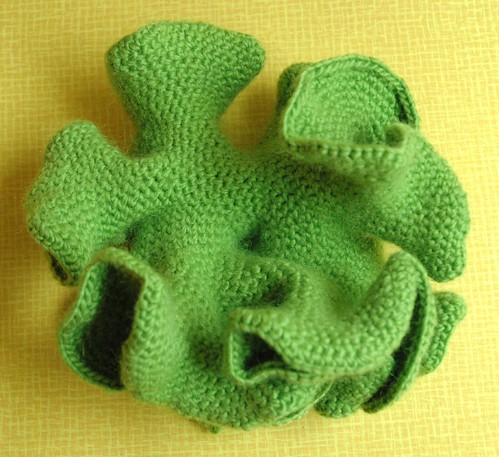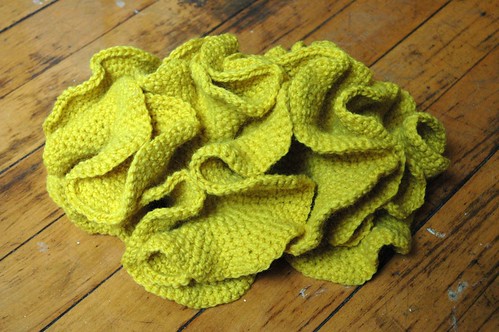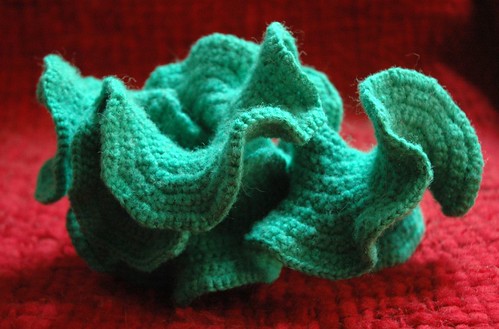in preparation for teaching my first big hyperbolic crochet class, i have decided to pour back through my related resources and write a little rundown of this mathematical handicraft to clarify my thoughts on it. i should start by saying that i am much more of a crocheter than a mathematician, so feel free to pipe up, whiz kids, if there are holes in my understanding or explanations.
my love affair with hyperbolic crochet was ignited on a fateful (in many ways, actually) trip to pittsburgh just under a year ago. jen and leah and i were there for the craft congress and took a free afternoon to go to the warhol museum. their special exhibit was a group show concenring climate change. on top of an amazing installation by the yes men (based on this intervention), there was a huge coral reef made entirely of crochet pieces. obviously, we craft nerds were enthralled. but it got even more interesting as we started to read about the complex mathematics behind this highly organic assemblage of shapes.
the coral reef, as it turns out, was the major installation project of the institute for figuring at that time. the institute itself is a fascinating organization that does a great deal of work bridging tactile reality with more complex and esoteric arts & sciences. in thier own words:
The Institute For Figuring is an organization dedicated to the poetic and aesthetic dimensions of science, mathematics and the technical arts.by the way, if you just poke around the hyperbolic resources on their website, you probably have a better chance of understanding hyperbolic crochet than i can give you.

leah and i each went home with the iff's new publication, a field guide to hyperbolic space. it's a great book and if any of this piques your interest, you should probably hunt down a copy (here).
oh man, this is where i have to explain the science behind the yarn. this part always freaks me out, so let's make it quick - hyperbolic crochet is the physical modeling of shapes that arise from a branch of mathematics once thought to be impossible (also a branch of mathematics that eventually disproved euclid's grand postulates of geometry - never postulate with grandeur; you will just end up with hyperbolic egg on your face).
as much as i enjoy hurting my brain with the math involved, the history of hyperbolic mathematics and its eventual crochet modeling is even more interesting. after hyperbolic mathematics was finally accepted as real (a long winding road), the challenge was set to create models of hyperbolic space. hyperbolic geometry, by the way, takes it's name from the literary term of hyperbole. in the geometric case, the hyperbole manifests itself in a continuing and constant excess of surface. put plainly, hyperbolic spaces can look all lettucey.

but back to the task of making hyperbolic models...
while these forms are easy enough to represent in two dimension or simulations of three dimension with computers, tactile models were proving harder to create. any brittle material (paper, wood) might indeed be made into a hyperbolic plane with some difficulty, but it could never be manipulated.
enter dr. daina taimina, a latvian mathematician and physicist who decided to pick up a crochet hook in 1997 to make workable hyperbolic models as aids for her students. revolutionary! funnily enough, once explained the basics of hyperbolic forms, even the most novice of crocheters could make just about any hyperbolic plane, but the breakthrough had eluded mathematicians for centuries. what's more, after sewing lines and shapes onto the models, incredibly complex mathematical theories can be easily observed (ie. the behaviors of straight lines and triangles in hyperbolic space).

my mind is too tangled to do justice to advanced geometry at the moment so it's time i left it to the pros and had this all explained to you much more succinctly by the iff.
as an added bonus, after your mind is blown by trying to envision existence in hyperbolic space you can have it double-blown considering the possibility that we may already be existing in it. but i'll leave that to you, dear reader, as i can only be responsible for so many physics-based panic attacks per day and i think i've eaten up too many already by myself.


No comments:
Post a Comment